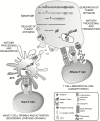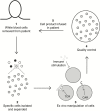Immunotherapy for pediatric brain tumors: past and present
- PMID: 31504801
- PMCID: PMC6784275
- DOI: 10.1093/neuonc/noz077
Immunotherapy for pediatric brain tumors: past and present
Abstract
The field of cancer immunotherapy has progressed at an accelerated rate over the past decade. Pediatric brain tumors thus far have presented a formidable challenge for immunotherapy development, given their typically low mutational burden, location behind the blood-brain barrier in a unique tumor microenvironment, and intratumoral heterogeneity. Despite these challenges, recent developments in the field have resulted in exciting preclinical evidence for various immunotherapies and multiple clinical trials. This work reviews the history and advances in active immunotherapy, checkpoint blockade, and adoptive T-cell therapy for pediatric brain tumors, including ongoing clinical trials.
Keywords: brain tumor; immunotherapy; pediatric.
© The Author(s) 2019. Published by Oxford University Press on behalf of the Society for Neuro-Oncology. All rights reserved. For permissions, please e-mail: journals.permissions@oup.com.
Figures



References
-
- Curtin SC, Minino AM, Anderson RN. Declines in cancer death rates among children and adolescents in the United States, 1999–2014. NCHS Data Brief. 2016;( 257):1–8. - PubMed
-
- Couzin-Frankel J. Breakthrough of the year 2013. Cancer immunotherapy. Science. 2013;342(6165):1432–1433. - PubMed
-
- Carrithers MD, Visintin I, Kang SJ, Janeway CA Jr. Differential adhesion molecule requirements for immune surveillance and inflammatory recruitment. Brain. 2000;123(Pt 6):1092–1101. - PubMed
Publication types
MeSH terms
Grants and funding
LinkOut - more resources
Full Text Sources
Medical
Miscellaneous

